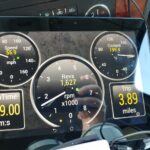It’s tempting to hit that reset button on your OBD2 scanner when the check engine light pops up, especially if you’re facing an upcoming emissions inspection. However, if you’re in a state that requires emissions testing, resetting your OBD2 codes might be the worst thing you can do right before your inspection. Why? Because doing so can actually cause you to automatically fail.
When you reset error codes, either by disconnecting your car battery or using the reset function on your OBD2 scanner, you’re not just turning off the light. You’re also erasing crucial emissions data that your car’s computer has stored. This data is gathered during what’s known as “self-test emissions,” which your vehicle performs every time you start and drive. These tests monitor various systems to ensure your car is running cleanly. If an emissions-related issue is detected, the check engine light illuminates, and an error code is generated.
Alt text: A handheld OBD2 scanner tool displaying diagnostic information during a car engine check, highlighting its role in automotive error detection.
The problem with resetting codes right before an inspection is that you wipe out all this stored emissions information. For your car to pass an emissions test, it needs to show that these self-tests have been completed and passed. After a reset, your car needs to go through a “drive cycle” to re-run these tests and store the new data. A drive cycle involves a specific pattern of starting, driving under varying conditions (both city and highway speeds), and shutting off your vehicle. This process can take up to 50 miles of driving, and until it’s complete, your car will show as “not ready” for emissions testing. Therefore, resetting before inspection means you’ll likely fail because the system hasn’t had time to confirm emissions readiness.
Now, if your state doesn’t have emissions inspections, or your inspection is far off, resetting might seem helpful. It will clear the check engine light, but it’s crucial to understand that resetting doesn’t fix the underlying problem. If the issue that triggered the light in the first place isn’t resolved, the light will simply come back on.
Furthermore, there are “pending codes.” These are errors that have been detected but haven’t yet triggered the check engine light. Even if you fix the issue and reset the codes, a pending code might still be present. These pending codes will also clear automatically after a few successful drive cycles if the problem doesn’t reappear. Many basic OBD2 scanners don’t distinguish between active and pending codes, which can be confusing.
A more advanced OBD2 scanner will display “readiness monitors.” These monitors show the status of the various emissions tests – whether they’ve passed or not. A good scanner will tell you if your vehicle is “READY” or “NOT READY” for emissions inspection. This is invaluable information for DIYers, allowing you to ensure your car is actually prepared before heading to the testing station. Understanding what an OBD2 scanner truly does – beyond just reading and resetting codes – is key to properly maintaining your vehicle and navigating emissions requirements.
